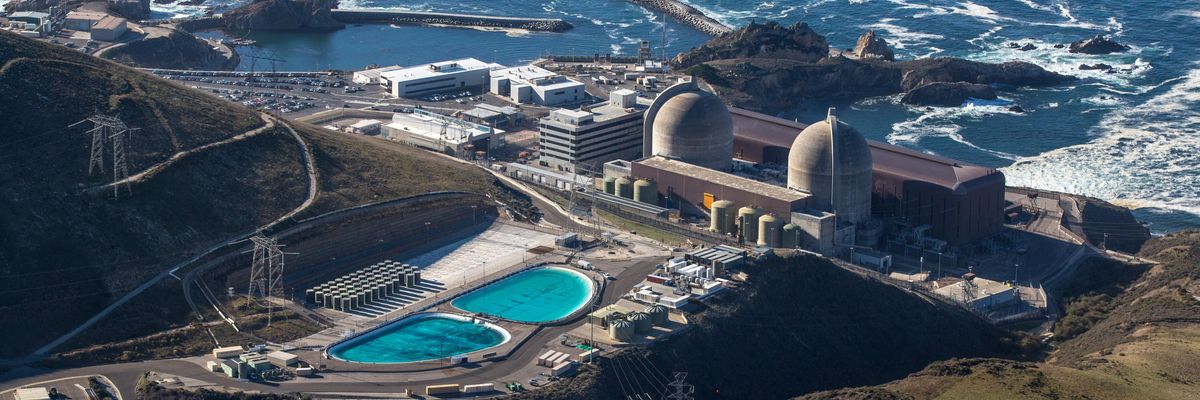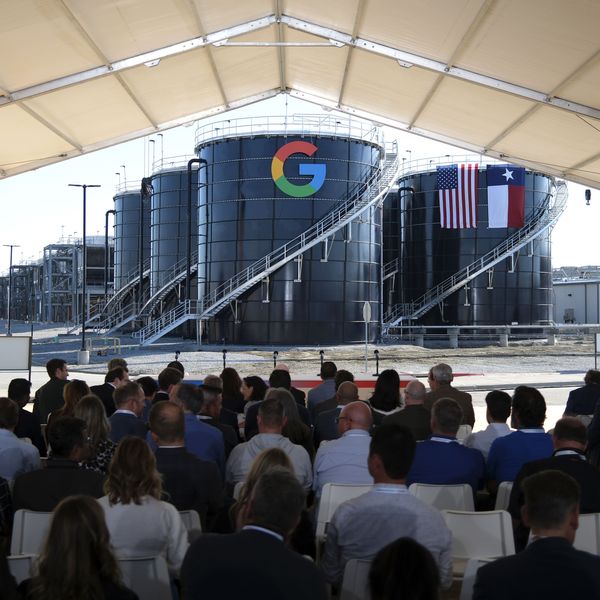
This aerial photograph of the Diablo Canyon nuclear power plant near Avila Beach, California was taken on December 1, 2021.
'Flawed Push' to Keep California Nuclear Plant Open Could Cost Customers $45 Billion
"The tens of billions it will cost to keep Diablo Canyon operating will ultimately be borne by PG&E's ratepayers, who already pay some of the highest electricity bills in the country," said one campaigner.
Keeping California's last nuclear power plant running could cost customers of the state's largest utility as much as $45 billion through 2045, according to an analysis published Tuesday.
Pacific Gas & Electric's (PG&E) Diablo Canyon Power Plant—located near Avila Beach in San Luis Obispo County—was slated to be closed in 2025. However, last September, California state lawmakers overwhelmingly approved legislation signed by Democratic Gov. Gavin Newsom to keep the nearly 37-year-old facility online until 2030, a decision Environmental Working Group (EWG) president Ken Cook called a "dangerous and dumb" impediment to "California's drive to make solar and wind the prevailing sources of electricity in the state."
"The power this problematic plant generates could easily be replaced by new clean energy investments."
In a move EWG blasted as a "cave to PG&E," the U.S. Nuclear Regulatory Commission in March subsequently approved the utility giant's continued operation of Diablo Canyon without a renewed license or safety review while the company seeks a 20-year extension.
The following month, the environmental advocacy group Friends of the Earth sued PG&E, arguing that the company breached its contract to close the plant.
If Diablo Canyon remains operational through 2045, EWG estimates PG&E customers would be on the hook for between $20 billion and $45 billion or more.
"And that's just the expense of prolonging the troubled facility's life," the green group said. "It doesn't account for the enormous extra costs that would be incurred following a major disaster like a reactor leak or an earthquake that damages the plant."
In a statement Tuesday, Cook said that "keeping Diablo Canyon open past its closure date is a terrible idea for many reasons, including the staggering price tag that unwitting ratepayers will face for keeping the dilapidated and dangerous nuclear plant operating."
"Let's be clear," he added, "the tens of billions it will cost to keep Diablo Canyon operating will ultimately be borne by PG&E's ratepayers, who already pay some of the highest electricity bills in the country, while the monopoly's shareholders will reap additional profits."
However, Grant Smith, EWG's energy adviser and a co-author of the new analysis, argued that "the power this problematic plant generates could easily be replaced by new clean energy investments."
California has committed to slashing planet-heating greenhouse gas emissions by 85% and achieving carbon neutrality by 2045 amid a worsening climate emergency.
An Urgent Message From Our Co-Founder
Dear Common Dreams reader, The U.S. is on a fast track to authoritarianism like nothing I've ever seen. Meanwhile, corporate news outlets are utterly capitulating to Trump, twisting their coverage to avoid drawing his ire while lining up to stuff cash in his pockets. That's why I believe that Common Dreams is doing the best and most consequential reporting that we've ever done. Our small but mighty team is a progressive reporting powerhouse, covering the news every day that the corporate media never will. Our mission has always been simple: To inform. To inspire. And to ignite change for the common good. Now here's the key piece that I want all our readers to understand: None of this would be possible without your financial support. That's not just some fundraising cliche. It's the absolute and literal truth. We don't accept corporate advertising and never will. We don't have a paywall because we don't think people should be blocked from critical news based on their ability to pay. Everything we do is funded by the donations of readers like you. Will you donate now to help power the nonprofit, independent reporting of Common Dreams? Thank you for being a vital member of our community. Together, we can keep independent journalism alive when it’s needed most. - Craig Brown, Co-founder |
Keeping California's last nuclear power plant running could cost customers of the state's largest utility as much as $45 billion through 2045, according to an analysis published Tuesday.
Pacific Gas & Electric's (PG&E) Diablo Canyon Power Plant—located near Avila Beach in San Luis Obispo County—was slated to be closed in 2025. However, last September, California state lawmakers overwhelmingly approved legislation signed by Democratic Gov. Gavin Newsom to keep the nearly 37-year-old facility online until 2030, a decision Environmental Working Group (EWG) president Ken Cook called a "dangerous and dumb" impediment to "California's drive to make solar and wind the prevailing sources of electricity in the state."
"The power this problematic plant generates could easily be replaced by new clean energy investments."
In a move EWG blasted as a "cave to PG&E," the U.S. Nuclear Regulatory Commission in March subsequently approved the utility giant's continued operation of Diablo Canyon without a renewed license or safety review while the company seeks a 20-year extension.
The following month, the environmental advocacy group Friends of the Earth sued PG&E, arguing that the company breached its contract to close the plant.
If Diablo Canyon remains operational through 2045, EWG estimates PG&E customers would be on the hook for between $20 billion and $45 billion or more.
"And that's just the expense of prolonging the troubled facility's life," the green group said. "It doesn't account for the enormous extra costs that would be incurred following a major disaster like a reactor leak or an earthquake that damages the plant."
In a statement Tuesday, Cook said that "keeping Diablo Canyon open past its closure date is a terrible idea for many reasons, including the staggering price tag that unwitting ratepayers will face for keeping the dilapidated and dangerous nuclear plant operating."
"Let's be clear," he added, "the tens of billions it will cost to keep Diablo Canyon operating will ultimately be borne by PG&E's ratepayers, who already pay some of the highest electricity bills in the country, while the monopoly's shareholders will reap additional profits."
However, Grant Smith, EWG's energy adviser and a co-author of the new analysis, argued that "the power this problematic plant generates could easily be replaced by new clean energy investments."
California has committed to slashing planet-heating greenhouse gas emissions by 85% and achieving carbon neutrality by 2045 amid a worsening climate emergency.
- Nuclear Critics Cry Foul as Newsom Reconsiders Diablo Canyon Closure ›
- Feds 'Cave to PG&E,' Allowing California Nuclear Plant to Keep Operating Sans Safety Review ›
- Friends of the Earth Sues PG&E Over Diablo Canyon Nuclear Extension ›
- Opinion | Expensive, Deadly, and 50 Years Old: It’s Time to Retire the Gavin Coal Plant | Common Dreams ›
Keeping California's last nuclear power plant running could cost customers of the state's largest utility as much as $45 billion through 2045, according to an analysis published Tuesday.
Pacific Gas & Electric's (PG&E) Diablo Canyon Power Plant—located near Avila Beach in San Luis Obispo County—was slated to be closed in 2025. However, last September, California state lawmakers overwhelmingly approved legislation signed by Democratic Gov. Gavin Newsom to keep the nearly 37-year-old facility online until 2030, a decision Environmental Working Group (EWG) president Ken Cook called a "dangerous and dumb" impediment to "California's drive to make solar and wind the prevailing sources of electricity in the state."
"The power this problematic plant generates could easily be replaced by new clean energy investments."
In a move EWG blasted as a "cave to PG&E," the U.S. Nuclear Regulatory Commission in March subsequently approved the utility giant's continued operation of Diablo Canyon without a renewed license or safety review while the company seeks a 20-year extension.
The following month, the environmental advocacy group Friends of the Earth sued PG&E, arguing that the company breached its contract to close the plant.
If Diablo Canyon remains operational through 2045, EWG estimates PG&E customers would be on the hook for between $20 billion and $45 billion or more.
"And that's just the expense of prolonging the troubled facility's life," the green group said. "It doesn't account for the enormous extra costs that would be incurred following a major disaster like a reactor leak or an earthquake that damages the plant."
In a statement Tuesday, Cook said that "keeping Diablo Canyon open past its closure date is a terrible idea for many reasons, including the staggering price tag that unwitting ratepayers will face for keeping the dilapidated and dangerous nuclear plant operating."
"Let's be clear," he added, "the tens of billions it will cost to keep Diablo Canyon operating will ultimately be borne by PG&E's ratepayers, who already pay some of the highest electricity bills in the country, while the monopoly's shareholders will reap additional profits."
However, Grant Smith, EWG's energy adviser and a co-author of the new analysis, argued that "the power this problematic plant generates could easily be replaced by new clean energy investments."
California has committed to slashing planet-heating greenhouse gas emissions by 85% and achieving carbon neutrality by 2045 amid a worsening climate emergency.
- Nuclear Critics Cry Foul as Newsom Reconsiders Diablo Canyon Closure ›
- Feds 'Cave to PG&E,' Allowing California Nuclear Plant to Keep Operating Sans Safety Review ›
- Friends of the Earth Sues PG&E Over Diablo Canyon Nuclear Extension ›
- Opinion | Expensive, Deadly, and 50 Years Old: It’s Time to Retire the Gavin Coal Plant | Common Dreams ›

